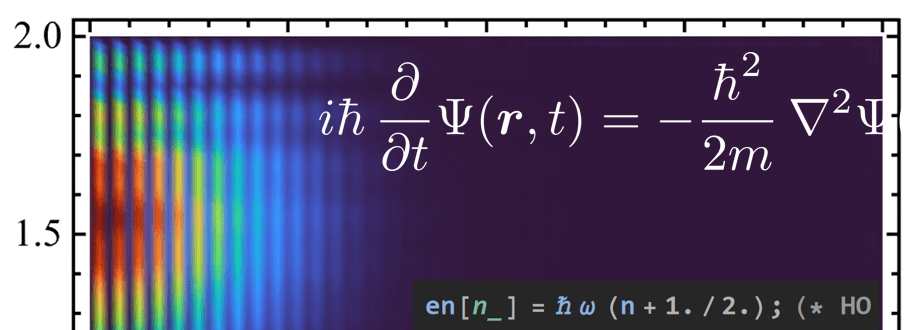Maybe the simplest animation of a quantum mechanical process. We match an initial condition in form of a Gaussian wave packet with non-zero momentum, and observe how this wave packet evolves with time. The main aspects of quantum mechanics covered in this project are:
- How to match an initial condition to eigenstates of the time-independent Schrödinger equation (TISE) with "Fourier's trick".
- Expectation values for position and momentum
- How to change the momentum of a wave packet
- Uncertainty principle and how it manifests itself in the time dependence
- Return time
Background
Following Griffith in notation, we summarize the minimal formalism needed for this project.
From the time dependent to the time independent Schrödinger equation
Consider the time-dependent Schrödinger equation (SE) in one dimension,
Through separation of variables the time dependence can be split off, if the potential is time-independent, . In that case, the full solution of the Schrödinger equation is given by the solutions of the time-independent Schrödinger equation,
that allows to include the time dependence according to
In fact, any linear combination will also solve the SE (1),
with the being complex coefficients to be matched to a chosen initial condition as discussed below. We refer to the
as energy eigenvalues because the TISE reads
in operator notation, with
being the Hamilton operator and
one of its eigenvalues.
The initial-value problem
Solving the initial-value problem means to determine the full time dependence of , given that at a specific time
it matches a chosen initial condition
,
To solve the initial-value problem, we must decompose the initial condition in terms of eigenfunctions because this will allow us to use Eq. (4) to write down the full time dependence. The overlap of the initial condition with the eigenfunctions is given by the complex Fourier coefficients
,
as described in Griffith in detail. We have now a method to determine all and, consequently, solve the initial-value problem. The animation below shows the time dependence of a solution matched to an initial condition in form of a Gaussian wave packet.
Units
Regarding units, a common choice is . This corresponds to natural units. In addition, choosing unit mass means that time and distance is in inverse mass units, so
and
has no units. In contrast, momenta and energies are expressed in mass units. The wave function is given in units of
which means that
is in units of inverse length, as it should be, being a probability distribution in x.
Animation
The time dependence of the Gaussian wave packet with nonzero initial momentum is shown below (blue, solid line), compared to the initial condition at (red, dashed line).
Note that we also show the expectation value of the momentum which is large and positive in the beginning, but the changes sign, as the wave packet is reflected. After some time, the wave packet is so "washed out" that the expectation value of momentum becomes small and only fluctuates a bit around zero.
